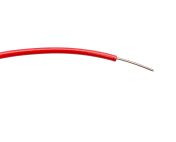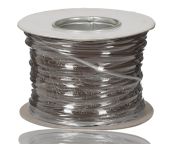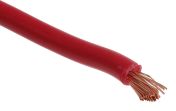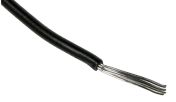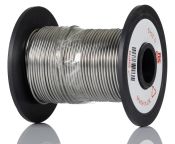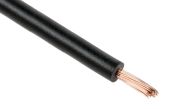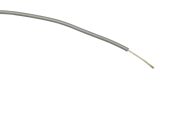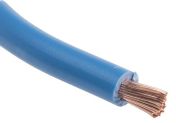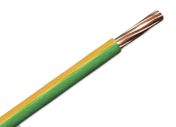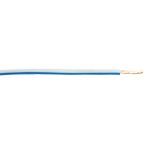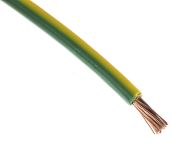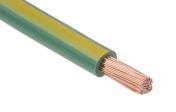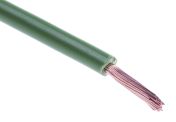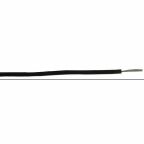Hook Up Wire
Hook-up wire is a term commonly used in electronics and electrical engineering, to refer to insulated electrical wires that are used for various electrical connections, such as electrical or stranded hook up wires. These wires typically have a solid or stranded core made of materials like copper or aluminium and are covered with a protective insulating material, such as PVC (polyvinyl chloride) or Teflon (PTFE). The insulation is colour-coded to indicate the wire's purpose and to help with proper identification in electrical circuits. The cross-sectional area of a hook-up wire is an important specification, typically measured in square millimetres (mm²), affecting its current-carrying capacity. Sheath colour provides additional identification, with common colours including red, black, white, blue, and green.
Hook-up wire is available in various gauges (wire diameters) to suit different applications, and it comes in different colours to facilitate organisation and identification within electrical circuits. The American Wire Gauge (AWG) system is often used to specify the wire diameter, with smaller numbers indicating larger diameters. Hook-up wires can have different core strand configurations, such as a single solid core or multiple strands twisted together for greater flexibility. It is sold in various lengths, from short pre-cut sections to spools of hundreds of metres. The colour coding often follows industry standards or specific conventions, such as red for positive (+) connections and black for negative (-) connections in direct current (DC) circuits.
When working on electrical or electronics projects, it's important to choose the appropriate gauge and type of hook-up wire for your specific application to ensure safety and proper functioning of the circuit. The insulation material, whether PVC, Teflon, or another type, should also be selected based on the environmental conditions and electrical requirements of the project.
What Are the Types of Hook Up Wire?
Here are some common types of hook-up wire:
- Single Conductor Wire: This is the most basic type of hook-up wire, consisting of a single insulated conductor. It's suitable for general-purpose use and available in various gauges and insulation materials.
- Stranded Wire: Stranded hook-up wire is made up of multiple smaller strands of wire twisted together. This construction makes it more flexible and suitable for applications where the wire may need to bend or flex.
- Solid Wire: Solid hook-up wire consists of a single, solid conductor. It's less flexible than stranded wire but is preferred in situations where minimal signal loss or resistance is crucial, such as in high-frequency applications.
- Shielded Wire: This type of wire has an additional layer of shielding, typically made of metal, around the insulated conductor. Shielded wire is used to protect against electromagnetic interference (EMI) and radio frequency interference (RFI). It's commonly used in audio and communication applications.
- High-Temperature Wire: For applications where extreme heat resistance is required, high-temperature hook-up wire is used. These wires are designed to withstand temperatures significantly higher than standard wire.
- Multi-Conductor Cable: While not technically a type of hook-up wire, multi-conductor cables consist of multiple insulated conductors bundled together within a single cable.
- Specialty Wire: Some applications require specialty hook-up wire, such as magnet wire (enamel-coated wire used in electromagnets and transformers) or automotive-grade wire (designed for use in vehicles).
- Harsh Environment Wire: Refers to electrical wiring and cables designed specifically for use in extreme or challenging environmental conditions. These conditions can include exposure to high temperatures, moisture, chemicals, physical abrasion, and other harsh factors that standard wires may not withstand.
Why Are Copper Wires Used as Connecting Wires?
Copper hook up wires are used as a connecting wire due to its excellent electrical conductivity, which allows efficient transmission of electricity with minimal energy loss. Copper hook up wire’s high ductility makes it easy to draw into thin wires without breaking, and its thermal conductivity ensures effective heat dissipation, preventing overheating. Additionally, copper is resistant to corrosion, ensuring long-term reliability and durability in various environmental conditions. These properties make copper an ideal choice for connecting wires in electrical and electronic applications.
Typical Applications & Industrial Applications
These wires are used in a wide range of applications, from simple breadboard prototypes to complex electronic devices. In the internal wiring of appliances, hook-up wires connect various components, ensuring reliable operation of devices like refrigerators, washing machines, and microwaves. In industrial settings, hook-up wires are crucial for connecting control panels, sensors, and actuators in automated machinery. For example, they are used in assembly lines to connect sensors that monitor production processes and relay information to central control units.
Additionally, in power distribution systems, hook-up wires connect transformers and switchgear, ensuring efficient power management and distribution across the facility. These wires are also essential in telecommunications, linking communication equipment to ensure seamless data transmission.
Hook Up Wire Price
The price of hook-up wire varies based on factors such as gauge (diameter), insulation material, length, and manufacturer. Typically, prices of hook up wire range from around MYR0.71 to MYR266 for a 100-foot spool. For example, a 100-foot spool of 22 AWG hook-up wire with PVC insulation might cost approximately MYR165.51 to MYR318.34, while specialised wires with Teflon insulation or larger gauges could be priced higher, reaching up to MYR2040 or more per 100 feet.
Popular Searches
Related links
- RS PRO Grey 0.33mm² Hook Up Wire 17/0.16 mm PVC Insulation
- RS PRO Brown 0.81mm² Hook Up Wire 16/0.25 mm PVC Insulation
- RS PRO Red 2.5mm² Hook Up Wire 7/0.67 mm PVC Insulation
- RS PRO Black 2.5mm² Hook Up Wire 50/0.25 mm PVC TI3 Insulation
- RS PRO Copper Brown 0.5mm² Hook Up Wire 1/0.8 mm PVC Insulation
- PVC HU wire 0,75 mm stranded BLK 100m
- Tie Wires
- Stranded Wire PVC 0.25mm CLR 100m

